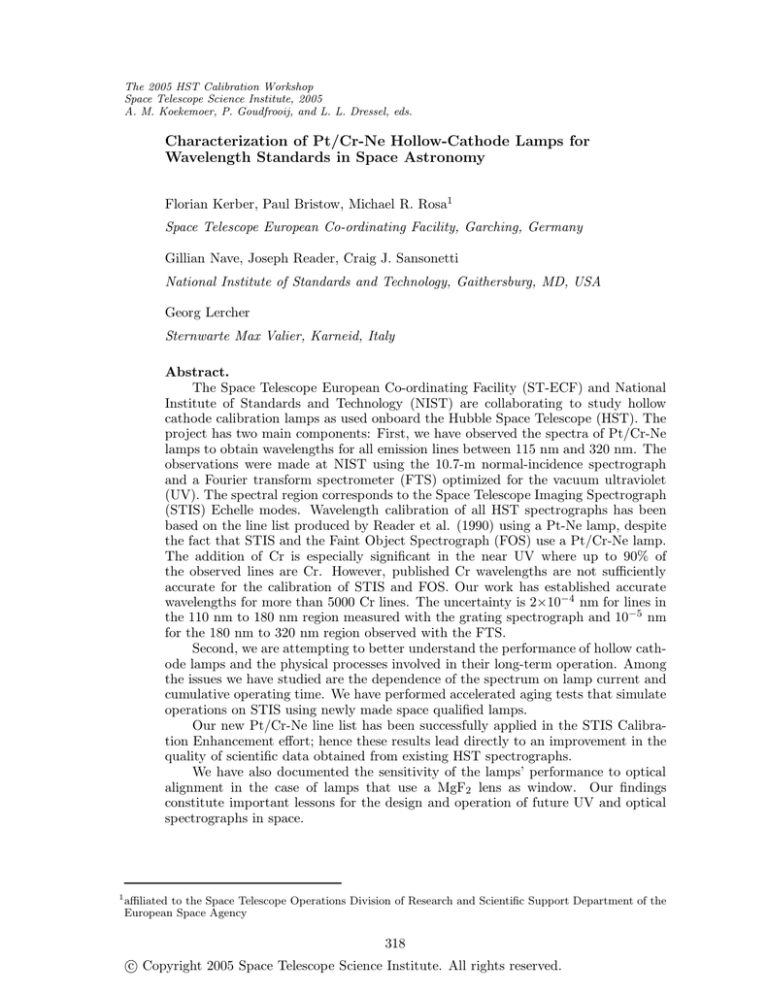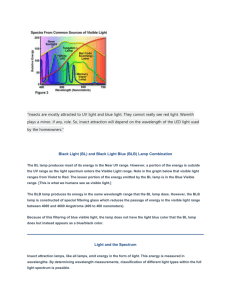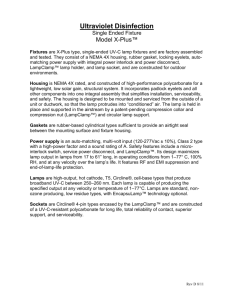
The 2005 HST Calibration Workshop
Space Telescope Science Institute, 2005
A. M. Koekemoer, P. Goudfrooij, and L. L. Dressel, eds.
Characterization of Pt/Cr-Ne Hollow-Cathode Lamps for
Wavelength Standards in Space Astronomy
Florian Kerber, Paul Bristow, Michael R. Rosa1
Space Telescope European Co-ordinating Facility, Garching, Germany
Gillian Nave, Joseph Reader, Craig J. Sansonetti
National Institute of Standards and Technology, Gaithersburg, MD, USA
Georg Lercher
Sternwarte Max Valier, Karneid, Italy
Abstract.
The Space Telescope European Co-ordinating Facility (ST-ECF) and National
Institute of Standards and Technology (NIST) are collaborating to study hollow
cathode calibration lamps as used onboard the Hubble Space Telescope (HST). The
project has two main components: First, we have observed the spectra of Pt/Cr-Ne
lamps to obtain wavelengths for all emission lines between 115 nm and 320 nm. The
observations were made at NIST using the 10.7-m normal-incidence spectrograph
and a Fourier transform spectrometer (FTS) optimized for the vacuum ultraviolet
(UV). The spectral region corresponds to the Space Telescope Imaging Spectrograph
(STIS) Echelle modes. Wavelength calibration of all HST spectrographs has been
based on the line list produced by Reader et al. (1990) using a Pt-Ne lamp, despite
the fact that STIS and the Faint Object Spectrograph (FOS) use a Pt/Cr-Ne lamp.
The addition of Cr is especially significant in the near UV where up to 90% of
the observed lines are Cr. However, published Cr wavelengths are not sufficiently
accurate for the calibration of STIS and FOS. Our work has established accurate
wavelengths for more than 5000 Cr lines. The uncertainty is 2×10−4 nm for lines in
the 110 nm to 180 nm region measured with the grating spectrograph and 10−5 nm
for the 180 nm to 320 nm region observed with the FTS.
Second, we are attempting to better understand the performance of hollow cathode lamps and the physical processes involved in their long-term operation. Among
the issues we have studied are the dependence of the spectrum on lamp current and
cumulative operating time. We have performed accelerated aging tests that simulate
operations on STIS using newly made space qualified lamps.
Our new Pt/Cr-Ne line list has been successfully applied in the STIS Calibration Enhancement effort; hence these results lead directly to an improvement in the
quality of scientific data obtained from existing HST spectrographs.
We have also documented the sensitivity of the lamps’ performance to optical
alignment in the case of lamps that use a MgF2 lens as window. Our findings
constitute important lessons for the design and operation of future UV and optical
spectrographs in space.
1
affiliated to the Space Telescope Operations Division of Research and Scientific Support Department of the
European Space Agency
318
c Copyright 2005 Space Telescope Science Institute. All rights reserved.
Wavelength Standards from Pt/Cr-Ne Hollow-cathode Lamps
1.
319
Introduction
The selection of a light source for wavelength calibration of space observatories is based on
practical considerations such as size, weight, power consumption, ruggedness and lifetime.
The most important property of such a calibration lamp is that it has to provide a very rich
spectrum at the resolution and in the range of the spectrograph. Based on these considerations a Pt(/Cr)-Ne hollow cathode lamp was chosen as the onboard emission line source for
wavelength calibration of the spectrographs onboard HST: the Goddard High Resolution
Spectrograph (GHRS), the Faint Object Spectrograph (FOS), the Space Telescope Imaging
Spectrograph (STIS), and the Cosmic Origins Spectrograph (COS).
The high spectral resolution of the GHRS (a few parts in 106 ) demanded that wavelengths of the Pt emission lines be known to the same level of accuracy from laboratory
data. A study at the National Institute of Standards and Technology (NIST) revealed that
the best available values dated back to the 1930s and that their quality was not sufficient
for use with GHRS. This fundamental issue was then addressed by Reader et al. (1990)
who characterized the Pt-Ne lamp with accurate measurements of about 3000 lines.
The spectral output of Pt-Ne lamps is fully adequate for pure UV instruments like
GHRS, with its wavelength range of 113 nm to 310 nm, where Pt has numerous emission
lines. However, in order to cover the extended range of UV-optical spectrographs such as
FOS and STIS, the addition of about 10 % Cr to the cathode is required. Pt/Cr-Ne lamps
provide a continuous distribution of suitable emission lines for the range 115 nm to 800 nm.
Although both FOS and STIS carried the Pt/Cr-Ne lamps, the pure Pt line list has been
the basis for wavelength calibration of all spectrographs onboard HST.
STIS is the first HST spectrograph to provide both high resolution modes (R = 100 000)
and large spectral coverage (115 nm to 1100 nm). For the STIS Calibration Enhancement
(STIS-CE) effort, conducted at the ST-ECF, we use a physical instrument model which describes the configuration of the optical elements and the geometrical distortion; see Ballester
& Rosa (1997) for details of this approach. In order to make full use of the capabilities of
the model description for wavelength calibration, it is essential to employ a highly accurate
and complete line list. For proper calibration of the STIS Echelle modes it is vital to use a
large number of lines all across the 2-D detector and to have a reasonable number of lines in
every order. This turned out to be impossible using the Pt-Ne line list since in some regions
of the near UV the number of Pt or Ne lines is small and 90 % of the lines emitted by the
lamp are from Cr. The existing literature data for Cr I (Kiess, 1953) and Cr II (Kiess,
1951) are not usable for STIS calibration enhancement purposes, since the Cr wavelengths
are usually reported to only 0.001 nm and cover only the wavelength region redward of 200
nm.
It was therefore necessary to initiate a project with the objective of obtaining wavelength standards from 115 nm to 320 nm in the spectrum of a Pt/Cr-Ne lamp. Only then
will we be able to achieve the wavelength scale accuracy STIS is potentially capable of.
Additionally, and as a secondary objective, we aimed at gaining improved insight into the
physical processes governing the performance and aging of such lamps; see also Kerber et
al. (2006). Such knowledge is highly relevant for the continued operation of calibration
lamps onboard HST, e.g. COS.
2.
Laboratory Work
All of the laboratory work was done at NIST. In order to cover the wavelength range of the
STIS Echelle modes - 115 nm to 320 nm - we used two instruments. For the far UV work we
operated the 10.7-m normal-incidence vacuum spectrograph which records the spectrum on
UV sensitive photographic plates (111.5 nm to 182.7 nm). This is the same instrument as the
one used by Reader et al. (1990) to measure the wavelengths and intensities of the emission
320
Kerber et al.
lines of the Pt-Ne hollow cathode lamp. We have produced a line list containing more than
1200 lines; the line list and all other relevant details of the work are presented in Sansonetti
et al. (2004). From the residuals in the fit of the wavelength interpolation polynomial to
the standard lines, we estimate that the measured wavelengths have an uncertainty of about
2×10−4 nm.
For the near UV work we used the Fourier Transform Spectrometer (FTS) located
at NIST’s Synchrotron UV Radiation Facility (SURF). We recorded the lamp spectrum
from about 155 nm to about 350 nm using two different photomultiplier detectors and a
filter. Actually, the recorded spectrum extends beyond 400 nm, albeit at rapidly decreasing
sensitivity. For the FTS spectra we achieved an accuracy of about 10−5 nm. For many Pt
lines the wavelength accuracy is limited by partially or fully resolved hyperfine structure
and isotope shifts. At the resolution of STIS, isotope splitting is not an issue, and the
hyperfine structure can easily be taken into consideration for calibration purposes.
Exposure times at the 10.7-m spectrograph were normally 3 h at 20 mA and 24 h at
10 mA. These times produced approximately equal exposures for lines of Pt II. At the FTS
we obtained between a few dozen and 2000 co-added spectra equivalent to exposure times
of 30 min to 24 h.
3.
Results and Application to STIS
Table 1 summarizes the results of both the far and near UV measurements. The new lists
provide highly accurate wavelengths of the emission lines in the spectrum of a Pt/Cr-Ne
lamp. In particular we have added data for about 5500 Cr lines, which could not be used
for wavelength calibration previously. A combination of the NIST Pt atlas and the new line
lists provides about 11500 lines for calibration purposes in the region 111.5 nm to 433.2 nm.
This forms the basis for the STIS-CE model-based wavelength calibration.
Table 1: Summary of the line lists from the far UV and near UV part of the lamp project.
More than 5000 Cr lines have been measured, identified, and are being used by STIS-CE.
4.
far UV (113.0 to 182.7) nm
FTS (155.0 to 433.2) nm
# of Pt lines
744
1280
# of Ne lines
105
590
# of Cr lines
258
≈5400
# of unidentified lines
128
<100
total # of lines
1235
7300
Dependence of Spectral Output upon Current
In our photographic spectra of the far UV region we recognized that the relative intensity
of the neon lines with respect to the metal lines was significantly enhanced at lower lamp
currents. In the near UV region the linear intensity response of the FTS enabled a more
quantitative investigation of the change in the spectrum as a function of operating current.
We took spectra at 7, 10 (standard current on STIS), 12, 15, 20, 25 and 30 mA.
Analysis of the spectra taken at different currents revealed a very well defined behavior
of the line intensities as a function of current. For every spectrum, we calculated the ratio of
the intensity of each observed line to the intensity of the same line in the 20 mA spectrum.
Wavelength Standards from Pt/Cr-Ne Hollow-cathode Lamps
321
Figure 1: Variation of the line intensities as a function of the operating current of the lamp.
Spectra were taken at 7, 10, 12, 15, 20, 25 and 30 mA. Note the pronounced difference in
the behavior of the gas and metal lines (left panel). The curves of the two metals Pt and
Cr show a less pronounced but still clear and characteristic difference in their response to
varying current (right panel).
We then averaged the ratios for all lines of a particular species at each current. The results,
which represent the average behavior of the line intensities as a function of current, are
displayed in Fig. 1. There is a very pronounced distinction between the behavior of the
metals and the gas lines. The gas lines show much higher intensities at lower currents.
The metal lines (right panel) show a much more limited variation with current but careful
analysis shows that the intensities of Pt and Cr lines vary in a distinct manner. A qualitative
explanation of this behavior is given in Kerber et al. (2004).
5.
Accelerated Aging Tests
An important secondary objective of the lamp project was to investigate the aging of Pt/CrNe hollow cathode lamps and any changes in spectral output or operational characteristics
associated with it. On STIS there is a total of three Pt/Cr-Ne lamps. During the 5.5
years of operation between installation in Feb 1997 and mid-2002, the LINE lamp had
been used for a total of 117.5 h, accumulated during more than 8600 exposures (J. Valenti
2002, private communication). On average this corresponds to about 3.5 min of lamp usage
per day on orbit. Most of the exposures taken are short; 91 % lasted less than 60 s, with
an average exposure time of about 31 s. To simulate the working conditions of the STIS
lamp we operated our lamps at 10 mA on an interval timer with 30 s on and 30 s off for
several months. At several times during this period, and at the end of the aging period, we
photographed the spectrum of the lamp on the normal-incidence spectrograph and compared
it to a spectrum taken at the beginning of the test. Little change in line ratios or even total
intensity has been found by us. A total of four Pt/Cr-Ne lamps have completed their aging
test. They lasted between 1000 h and more than 2500 h. Lamp #16 had a depleted getter
when we received it (barium coating inside the lamp that helps maintain a clean environment
by trapping impurities) and showed an unusually rapid voltage increase from the beginning
of the test. All lamps failed in a similar manner showing an anomalous discharge covering
the first mica spacer. We speculate that the metal deposited there could form a conducting
layer on the spacer leading to failure of the lamp.
The only obvious change observed before failure is an increase in operating voltage
(Fig. 2), which could indicate a change in the rare gas pressure or in the cathode dimensions.
Since the operating voltage seems to be the best diagnosis of lamp aging, and since it can
easily be monitored, we strongly suggest that this voltage be part of the telemetry of future
instruments and that it be used for analysis of the lamp’s performance.
322
Kerber et al.
Figure 2: Change of the operating voltage - required for a current of 10 mA - as a function
of accumulated operating time. The lamp was operated in a 30 s on / 30 s off duty cycle in
order to mimic the operations onboard STIS. The lamps lasted for between 1000 h and 2500
h. All four lamps failed after experiencing an increase of 10 to 20 V in operating voltage.
6.
Alignment for lamps with a MgF2 lens
The lamps used on IUE, FOS, GHRS and STIS all have been ruggedized for use in space;
this includes a special Kovar flange to mount the exit window, which consists of a single
plano-convex lens made of MgF2 . Such a lens gives high transparency down to the cut-off
of MgF2 at 115 nm and focuses the light from the cathode. Since the index of refraction of
MgF2 is wavelength dependent and increases sharply below 150 nm, chromatic aberration is
unavoidable with a single lens and perfect focus can be achieved at only a single wavelength.
For the laboratory measurements on the 10.7-m vacuum spectrograph, initial alignment
was achieved visually by optimizing the illumination and brightness of the slit image as
seen in the plate holder. With this alignment both the FOS and GHRS lamps produced
reasonable spectra at long wavelengths. For the FOS lamp, however, the spectrum became
progressively weaker toward shorter wavelengths, and below about 150 nm only the strongest
lines were observed. Close inspection showed that the approximately focussed image of the
hollow cathode discharge was moving off the side of the slit at short wavelengths. This
suggests that the optical axis of the MgF2 lens did not coincide with the axis of the discharge.
The complete 5.5 h spectrum of the FOS lamp, at a highly compressed wavelength scale, is
shown in the upper panel of Fig. 3. Quite evidently, careful alignment in the visible part of
the spectrum was not sufficient to guarantee good alignment in the vacuum UV. A greatly
improved spectrum was obtained, as shown in the lower panel of Figure 3, after we realigned
the lamp using a photomultipler and the strong Pt II line at 124.8 nm. The intensity of the
spectrum is increased by a factor 12 at 160 nm. At shorter wavelengths the improvement
is even greater but cannot be accurately quantified because of the lack of comparison lines.
7.
Summary
• We have measured the spectrum of Pt/Cr-Ne hollow cathode lamps in the range 115
nm - 433 nm adding accurate wavelengths for about 5000 Cr lines.
• This new line list has successfully been used as input for instrument model based
dispersion solutions provided by the STIS Calibration Enhancement project.
Wavelength Standards from Pt/Cr-Ne Hollow-cathode Lamps
323
Figure 3: The spectrum of an FOS lamp after alignment in the visible (upper panel) and
after alignment in the UV (lower panel). The dramatic increase in the line intensity at
shorter wavelengths illustrates the strong sensitivity to alignment that results from use of
a single element MgF2 lens. See text for details.
• The lamps are very stable sources throughout their lifetime of about 1500 h at 10 mA
during accelerated aging test that mimicked operations onboard STIS.
• The best indicator of lamp aging is an increasing operating voltage for a given current.
We strongly recommend that this parameter be included in the standard telemetry
for future instruments.
• MgF2 singlet windows introduce chromatic alignment sensitivity that can lead to
severe light loss if the lamps are not properly aligned. Alignment in the UV is essential.
Acknowledgments. This work was funded by the European Space Agency (ESA). We
are grateful to D. Macchetto for his support throughout the project. We thank the HST
project and the STIS IDT, in particular M. Niedner, B. Woodgate, T. Gull, R. Kimble for
providing some of their back up lamps on loan.
References
Ballester, P., Rosa, M.R., 1991, A&AS, 126, 563
Kerber, F., Lindler, D., Bristow, P., Lembke, D., Nave, G., Reader, J., Sansonetti, C.J.,
Heap, S.R., Rosa, M.R., Wood, H.J., 2006, The 2005 HST Calibration Workshop.
Eds. A. M. Koekemoer, P. Goudfrooij, & L. L. Dressel, this volume, 324
Kerber, F., Rosa, M.R., Sansonetti, C.J., Reader, J., Nave, G., Bristow, P., Fiorentino, M.,
Lercher, G., 2004, SPIE 5488, 679
Kerber, F. & Wood, H.J., 2004, ST-ECF Newsletter, 35, 5
Kiess, C.C., 1953, J. Res. Natl. Bur. Stand. (US), 51, 247
Kiess, C.C., 1951, J. Res. Natl. Bur. Stand. (US), 47, 385
Reader, J., Acquista, N., Sansonetti, C.J., Sansonetti, J.E., 1990, ApJS, 72, 831
Sansonetti, C.J., Kerber, F., Reader, J., Rosa, M.R., 2004, ApJS, 153, 555





